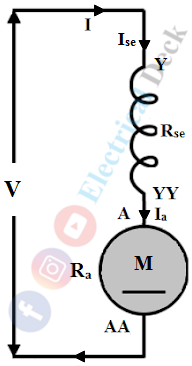Basically, there is no difference in the construction of a dc motor and dc generator. A dc motor gives a mechanical output with input as a dc supply while the dc generator gives dc electrical output with mechanical input. Similar to the dc generators, the dc motors are also classified on the method of interconnecting the windings (armature and field).
Depending upon the method of connecting field and armature windings of a dc motor. The various types of dc motors obtained are,- Permanent Magnet DC Motor
- Separately-Excited DC Motor
- Self-Excited DC Motor
- DC shunt motor
- DC series motor
- DC compound motor
- DC short-shunt compound motor
- DC long-shunt compound motor
- DC shunt motor
- DC series motor
- DC compound motor
- DC short-shunt compound motor
- DC long-shunt compound motor
Here we can see that the self-excited dc motors are further classified as dc shunt, series, and compound motors. Again the compound motors are classified as long-shunt and short-shunt compound motors. Let us discuss briefly the types of dc motors.
Separately-Excited DC Motor :
As the name implies the dc motor is excited by a separate dc source i.e., field excitation as shown below. It means that there is no electrical connection between armature and field winding and both are fed from different dc sources. This ensures that the field current is independent of the load and is given by V/Rf, where V = applied field voltage and Rf = field resistance.
Therefore, the equation for gross torque produced by a separately-excited dc motor is given by, Tg = Ka Φ Ia. Since T ∝ Φ Ia, the flux Φ produced by the field winding is independent of Ia and proportional to field current If. Hence, the torque produced can be varied by the varying field current If.
Self-Excited DC Motors :
In self-excited dc motors, both field and armature windings are supplied through a common dc source. Depending upon how the field winding is connected with the armature winding the following types of dc self-excited motors are available,
- DC Shunt Motor (parallel connection),
- DC Series Motor (series connection),
- DC Compound Motor (parallel and series connection).
DC Shunt Motor :
If the field winding is connected in parallel or across the armature winding then the motor is said to be a dc shunt motor. The parallel combination of field and armature winding is then connected to the dc supply as shown below.
Where,- Rsh = Shunt field resistance,
- Ra = Armature winding resistance,
- V = Supply voltage.
Since the field and armature windings are in parallel connection supply voltage will be equal. The total current drawn will be the sum of armature and field windings currents i.e., I = Ia + Ish, where Ish = V/Rsh. The voltage equation is given by,
Here Eb = motor back emf and BCD = brush contact drop. Generally, BCD is very small and can be neglected. Now the torque produced depends upon flux (T ∝ Φ) and the flux produced is proportional to field current (Φ ∝ Ish). As long as the supply voltage is constant field current Ish remains constant and hence torque. Hence, the dc shunt motor is a constant flux or constant speed motor.
DC Series Motor :
In dc series motor the field and armature are connected in series with supply as shown below. Since both the windings are in series connection the current through them will be the same i.e., equal to supply.
Where,- Rse = Series field resistance,
- Ra = Armature winding resistance,
- V = Supply voltage.
If I, is the supply current, for a dc series motor I = Ise = Ia. The voltage equation is given by,
Here, the supply voltage has to balance the series field drop in addition to armature and back emf (Eb) drops. Since the entire field current is available at the armature winding. The flux produced will be proportional to armature current i.e., Φ ∝ Ise ∝ Ia. Therefore, the torque developed will be proportional to the square of the current i.e., T ∝ Ia Φ ∝ Ia2.
DC Compound Motor :
A dc compound motor is a combination of both dc shunt and series motors. It consists of two field windings a part connected in series and a part in parallel with the armature. It has the combined features of a dc shunt and series motors.
In a compound motor, the shunt (parallel) field winding can be further connected in two ways, in parallel with the armature winding only, or in parallel with both armature and series field windings. Thus the dc compound motors are further classified as,
- DC Short-Shunt Compound Motor
- DC Long-shunt Compound Motor
DC Short-Shunt Compound Motor :
In short-shunt compound motor, the shunt field is connected only across the armature winding as shown below.
Here, the series field current will same as the supply current i.e., I = Ise, and the supply current will be the sum of the armature and shunt field currents i.e., I = Ia + Ish. The voltage equation is given as,
DC Long-Shunt Compound Motor :
In long-shunt compound motor, the shunt field is connected across both armature and series field as shown below.
Here, supply current is the sum of series field and shunt field currents i.e., I = Ish + Ise, and armature current is equal to the series field current i.e., Ia = Ise. The voltage equation is given as,
In both short-shunt and long-shunt compound motors, two conditions may arise. If the two field windings are wound in such a way that,





